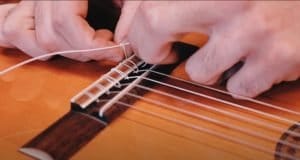Table of Contents
The vibrato technique is a widely acclaimed classical guitar style that involves a regular, pulsing change in a note’s pitch. It has become a defining aspect of classical guitar music, allowing musicians to express a wide range of emotions through their performances by adding expressiveness to a static note without totally changing its pitch.
A minor change in tone can convert a flat performance into one filled with passion and emotion. It has evolved, with many schools of technique connected with prominent virtuosos such as Mauro Giuliani (1781-1829), who was famed for his arpeggio playing. Let’s introduce you to some of the basic principles of vibrato.
Have you checked other guitar techniques you must know?
Basic Principles of Vibrato
Proper left-hand positioning is crucial for effective vibrato. The classical guitarist uses axial vibrato, where the string is stretched along its length in a straight line rather than being bent. Rolling the finger behind the fret does not change the pitch, as the classical guitar uses frets to determine the note’s pitch.

Instead, the player applies pressure to push and pull the string, altering the pitch. The rolling movement is a byproduct of this technique. Vibrato requires a controlled wrist motion to create the pulsating pitch change.
The guitarist must balance the speed and width of the vibrato to suit the musical expression. A relaxed wrist motion ensures a smooth and expressive vibrato.
Developing Finger Flexibility and Control
Left-hand warm-up exercises are essential to achieving finger independence and control. These exercises can include trills, scales, and arpeggios, gradually building finger strength and flexibility.
As a guitarist progresses, they should gradually increase the speed and width of their vibrato. This allows for a more nuanced and expressive vibrato, enhancing the overall musicality of their performances.
Vibrato Variations and Styles
Classical guitar vibrato offers diverse variations and styles, enriching the music with expressive and lyrical qualities. It involves creating rapid and regular fluctuations in pitch, loudness, or timbre, resulting in a more emotionally charged and vibrant sound.
Standard Vibrato
Standard vibrato is the most used technique by the guitarists. It can be soft or loud, big or small, sharp or smooth, and a thousand other things. This is the one you should focus on learning the most.
When you play an instrument with standard vibrato, you move your wrist quickly back and forth to make the strings vibrate. This makes the sound vibrate, which gives it more depth and richness. Vibrato can be used slightly to add depth to a performance or, more dramatically, to make people feel passionate or excited.

The method is similar to the method for string bending, so if you haven’t learned that method yet, you might want to do that, too.
String blending and standard vibrato create a rich and unified sound. Vibrato helps blend the strings by adding a pulsating effect to fill the sound. String blending helps ensure that the vibrato is even and consistent across all strings.
The Radius Vibrato Technique
The Radius/Ulna Vibrato is a wrist-based guitar vibrato technique commonly used by guitarists. It involves rocking the hand back and forth along the guitar’s neck, producing a subtle pitch fluctuation. This technique allows for smooth and controlled vibrato with variations in speed and width.
Rocker Vibrato Technique
Rocker Vibrato involves bending the string repeatedly using the finger behind the fret, creating a narrow and intense vibrato. This technique requires precision and finger strength to achieve a vibrant and expressive sound.
The Push-Pull Vibrato Technique
The Push-Pull Vibrato is a forearm-based technique commonly utilized by blues and rock guitarists. It involves pushing the guitar neck away with the thumb while pulling back with the fingers, causing the string to vibrate rapidly. This technique allows for wide and expressive vibrato, adding a dynamic and soulful touch to the music.
Behind the Nut Vibrato Technique
Behind the Nut Vibrato is an unconventional technique where guitarists apply vibrato by pushing or pulling the strings behind the guitar’s nut. This produces a unique and eerie effect, often used for special musical accents or creating atmospheric sounds.
How to Do Vibrato on Guitar
To create vibrato on the guitar, you must combine both pulling and pushing motions on the string, effectively mimicking what the tuning pegs do. This technique involves tightening and slackening the strings to produce a pleasing vibrato effect:
Horizontal Vibrato
In the horizontal vibrato, you pull the string slightly towards the tuning pegs and then push it back towards the bridge. Pulling the string towards the tuning pegs tightens the tension and raises the pitch, while moving it towards the bridge lowers the pitch.
Combining these movements distorts the pitch slightly above and below the original note, creating a compelling vibrato effect. This method is often used on both acoustic and electric guitars.
Vertical Vibrato (Electric Guitar)
On the electric guitar, players may often use a different vibrato technique that involves bending the string vertically toward the other strings. This bending action also tightens the string, raising the pitch. However, with this technique, making the pitch go below the original note is challenging.
This approach is more common on electric guitars due to the higher tension of their strings. While it can be used on classical (nylon-string) guitars for specific expressive moments, the classical guitar technique typically leans towards the more subtle horizontal vibrato described earlier.
What is a Vibrato bar?
Vibrato bars, commonly called whammy bars, are mechanical devices found on electric guitars that allow the player to temporarily change the pitch of the strings. This effect is achieved by altering the tension of the strings, which in turn affects their frequency and pitch. The vibrato bar is typically attached to the bridge or tailpiece of the guitar and is operated by a lever that the player can move up and down.
The Difference between Vibrato and Tremolo
Vibrato and tremolo are different musical effects that can be used on a guitar. Vibrato changes the pitch of a note, while tremolo changes the volume of a note.
Here is a table that summarizes the key differences between vibrato and tremolo:
| Characteristic | Quickly and repeatedly picking up the string | Tremolo |
| Changes | Pitch | Volume |
| Created by | Moving your finger back and forth across the fret | Quickly and repeatedly picking the string |
| Effect | Vibrating effect | Pulsing effect |
| Uses | Add expression and emotion to your playing, and create various sounds. | To create a variety of different sounds, such as a tremolo bar on an electric guitar or a rapid strumming pattern on an acoustic guitar |
Flat or Sharp?
Guitar vibrato can be flat, sharp, or even a combination of both. It depends on the player’s technique and the desired effect.
Flat vibrato is when the pitch of the note is slightly lowered below the original pitch. This can be used to create a more mellow or haunting sound. To do flat vibrato, move your finger back and forth across the fret in a way that lowers the pitch of the note.
Sharp vibrato is when the pitch of the note is slightly raised above the original pitch. This can be used to create a brighter or more aggressive sound. To do a sharp vibrato, move your finger back and forth across the fret in a way that raises the pitch of the note.
A combination of flat and sharp vibrato can create a more complex and nuanced sound. This is often used in classical and jazz music.
Easy Vibrato Exercises:
I am providing two easy vibrato examples here to help you understand. Once you get used to these exercises, you can move on to the next level.
Wide & Slow
Mastering the slow and wide vibrato technique takes practice and patience, but you can develop it with consistent effort.
First, we’ll “shake” the note with the finger on the fretting hand, which will take it out of tune. Then, we’ll let it go back into tune. And it will look like a tiny bend.

Here is a piece of vibrato for you all.
Narrow & Fast
Use the same method but speed up the vibrato. We’ll shake a little faster and make the “shaking” move smaller and narrower.
The fingertips should rest lightly on the string for the vibrato motion to work.

So Much To Explore
The vibrato technique in classical guitar offers a powerful means of expression. Its historical significance and various nuances make it a captivating aspect of classical guitar music.
By mastering the fundamental principles, developing finger flexibility, and exploring different vibrato variations and styles, guitarists can unlock the full potential of this mesmerizing technique and enrich their performances with heartfelt emotion and musical depth.
Vibrato FAQs
Vibrato can be challenging for beginners, especially when first learning the technique. It requires control, precision, and finger strength. Developing a smooth and controlled vibrato motion takes time and practice.
However, with consistent practice and guidance, beginners can gradually improve their vibrato technique and incorporate it into their playing.
Yes, guitar players frequently use vibrato as a fundamental expressive technique. Vibrato adds depth, emotion, and character to the sound of the guitar. It is a common technique across various guitar styles, including rock, blues, jazz, classical, and more. Guitarists use vibrato to infuse their playing with nuance, convey emotions, and make their melodies and solos more dynamic and engaging.
Lorem ipsum dolor sit amet, consectetur adipiscing elit, sed do eiusmod tempor incididunt ut labore et dolore magna aliqua. Ut enim ad minim veniam, quis nostrud exercitation ullamco laboris nisi ut aliquip ex ea commodo consequat.
- Budget Classical Guitars Under $700 - February 15, 2025
- How To Set Up A 12-String Guitar Perfectly - September 8, 2023
- Vibrato Techniques: A Comprehensive Guide - September 6, 2023









